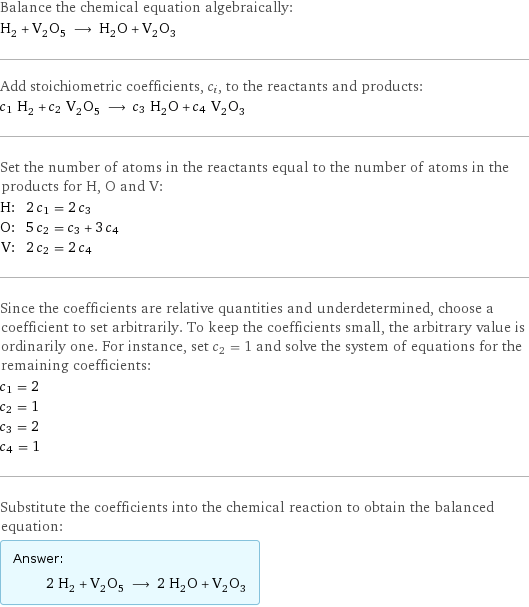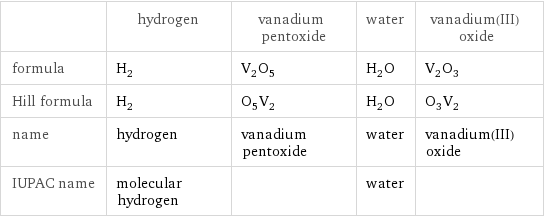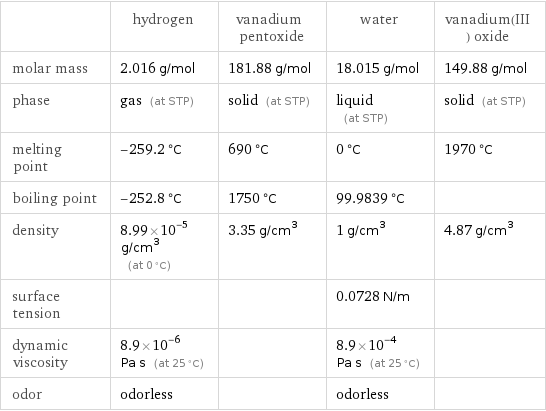Input interpretation

H_2 hydrogen + V_2O_5 vanadium pentoxide ⟶ H_2O water + V_2O_3 vanadium(III) oxide
Balanced equation

Balance the chemical equation algebraically: H_2 + V_2O_5 ⟶ H_2O + V_2O_3 Add stoichiometric coefficients, c_i, to the reactants and products: c_1 H_2 + c_2 V_2O_5 ⟶ c_3 H_2O + c_4 V_2O_3 Set the number of atoms in the reactants equal to the number of atoms in the products for H, O and V: H: | 2 c_1 = 2 c_3 O: | 5 c_2 = c_3 + 3 c_4 V: | 2 c_2 = 2 c_4 Since the coefficients are relative quantities and underdetermined, choose a coefficient to set arbitrarily. To keep the coefficients small, the arbitrary value is ordinarily one. For instance, set c_2 = 1 and solve the system of equations for the remaining coefficients: c_1 = 2 c_2 = 1 c_3 = 2 c_4 = 1 Substitute the coefficients into the chemical reaction to obtain the balanced equation: Answer: | | 2 H_2 + V_2O_5 ⟶ 2 H_2O + V_2O_3
Structures

+ ⟶ +
Names

hydrogen + vanadium pentoxide ⟶ water + vanadium(III) oxide
Reaction thermodynamics
Enthalpy

| hydrogen | vanadium pentoxide | water | vanadium(III) oxide molecular enthalpy | 0 kJ/mol | -1551 kJ/mol | -285.8 kJ/mol | -1219 kJ/mol total enthalpy | 0 kJ/mol | -1551 kJ/mol | -571.7 kJ/mol | -1219 kJ/mol | H_initial = -1551 kJ/mol | | H_final = -1790 kJ/mol | ΔH_rxn^0 | -1790 kJ/mol - -1551 kJ/mol = -239.9 kJ/mol (exothermic) | | |
Gibbs free energy

| hydrogen | vanadium pentoxide | water | vanadium(III) oxide molecular free energy | 0 kJ/mol | -1420 kJ/mol | -237.1 kJ/mol | -1139 kJ/mol total free energy | 0 kJ/mol | -1420 kJ/mol | -474.2 kJ/mol | -1139 kJ/mol | G_initial = -1420 kJ/mol | | G_final = -1614 kJ/mol | ΔG_rxn^0 | -1614 kJ/mol - -1420 kJ/mol = -194 kJ/mol (exergonic) | | |
Equilibrium constant
![Construct the equilibrium constant, K, expression for: H_2 + V_2O_5 ⟶ H_2O + V_2O_3 Plan: • Balance the chemical equation. • Determine the stoichiometric numbers. • Assemble the activity expression for each chemical species. • Use the activity expressions to build the equilibrium constant expression. Write the balanced chemical equation: 2 H_2 + V_2O_5 ⟶ 2 H_2O + V_2O_3 Assign stoichiometric numbers, ν_i, using the stoichiometric coefficients, c_i, from the balanced chemical equation in the following manner: ν_i = -c_i for reactants and ν_i = c_i for products: chemical species | c_i | ν_i H_2 | 2 | -2 V_2O_5 | 1 | -1 H_2O | 2 | 2 V_2O_3 | 1 | 1 Assemble the activity expressions accounting for the state of matter and ν_i: chemical species | c_i | ν_i | activity expression H_2 | 2 | -2 | ([H2])^(-2) V_2O_5 | 1 | -1 | ([V2O5])^(-1) H_2O | 2 | 2 | ([H2O])^2 V_2O_3 | 1 | 1 | [V2O3] The equilibrium constant symbol in the concentration basis is: K_c Mulitply the activity expressions to arrive at the K_c expression: Answer: | | K_c = ([H2])^(-2) ([V2O5])^(-1) ([H2O])^2 [V2O3] = (([H2O])^2 [V2O3])/(([H2])^2 [V2O5])](../image_source/6005757f639cb5ddd0ad0e23cc370697.png)
Construct the equilibrium constant, K, expression for: H_2 + V_2O_5 ⟶ H_2O + V_2O_3 Plan: • Balance the chemical equation. • Determine the stoichiometric numbers. • Assemble the activity expression for each chemical species. • Use the activity expressions to build the equilibrium constant expression. Write the balanced chemical equation: 2 H_2 + V_2O_5 ⟶ 2 H_2O + V_2O_3 Assign stoichiometric numbers, ν_i, using the stoichiometric coefficients, c_i, from the balanced chemical equation in the following manner: ν_i = -c_i for reactants and ν_i = c_i for products: chemical species | c_i | ν_i H_2 | 2 | -2 V_2O_5 | 1 | -1 H_2O | 2 | 2 V_2O_3 | 1 | 1 Assemble the activity expressions accounting for the state of matter and ν_i: chemical species | c_i | ν_i | activity expression H_2 | 2 | -2 | ([H2])^(-2) V_2O_5 | 1 | -1 | ([V2O5])^(-1) H_2O | 2 | 2 | ([H2O])^2 V_2O_3 | 1 | 1 | [V2O3] The equilibrium constant symbol in the concentration basis is: K_c Mulitply the activity expressions to arrive at the K_c expression: Answer: | | K_c = ([H2])^(-2) ([V2O5])^(-1) ([H2O])^2 [V2O3] = (([H2O])^2 [V2O3])/(([H2])^2 [V2O5])
Rate of reaction
![Construct the rate of reaction expression for: H_2 + V_2O_5 ⟶ H_2O + V_2O_3 Plan: • Balance the chemical equation. • Determine the stoichiometric numbers. • Assemble the rate term for each chemical species. • Write the rate of reaction expression. Write the balanced chemical equation: 2 H_2 + V_2O_5 ⟶ 2 H_2O + V_2O_3 Assign stoichiometric numbers, ν_i, using the stoichiometric coefficients, c_i, from the balanced chemical equation in the following manner: ν_i = -c_i for reactants and ν_i = c_i for products: chemical species | c_i | ν_i H_2 | 2 | -2 V_2O_5 | 1 | -1 H_2O | 2 | 2 V_2O_3 | 1 | 1 The rate term for each chemical species, B_i, is 1/ν_i(Δ[B_i])/(Δt) where [B_i] is the amount concentration and t is time: chemical species | c_i | ν_i | rate term H_2 | 2 | -2 | -1/2 (Δ[H2])/(Δt) V_2O_5 | 1 | -1 | -(Δ[V2O5])/(Δt) H_2O | 2 | 2 | 1/2 (Δ[H2O])/(Δt) V_2O_3 | 1 | 1 | (Δ[V2O3])/(Δt) (for infinitesimal rate of change, replace Δ with d) Set the rate terms equal to each other to arrive at the rate expression: Answer: | | rate = -1/2 (Δ[H2])/(Δt) = -(Δ[V2O5])/(Δt) = 1/2 (Δ[H2O])/(Δt) = (Δ[V2O3])/(Δt) (assuming constant volume and no accumulation of intermediates or side products)](../image_source/485f4151d04db98134a409ea4581d289.png)
Construct the rate of reaction expression for: H_2 + V_2O_5 ⟶ H_2O + V_2O_3 Plan: • Balance the chemical equation. • Determine the stoichiometric numbers. • Assemble the rate term for each chemical species. • Write the rate of reaction expression. Write the balanced chemical equation: 2 H_2 + V_2O_5 ⟶ 2 H_2O + V_2O_3 Assign stoichiometric numbers, ν_i, using the stoichiometric coefficients, c_i, from the balanced chemical equation in the following manner: ν_i = -c_i for reactants and ν_i = c_i for products: chemical species | c_i | ν_i H_2 | 2 | -2 V_2O_5 | 1 | -1 H_2O | 2 | 2 V_2O_3 | 1 | 1 The rate term for each chemical species, B_i, is 1/ν_i(Δ[B_i])/(Δt) where [B_i] is the amount concentration and t is time: chemical species | c_i | ν_i | rate term H_2 | 2 | -2 | -1/2 (Δ[H2])/(Δt) V_2O_5 | 1 | -1 | -(Δ[V2O5])/(Δt) H_2O | 2 | 2 | 1/2 (Δ[H2O])/(Δt) V_2O_3 | 1 | 1 | (Δ[V2O3])/(Δt) (for infinitesimal rate of change, replace Δ with d) Set the rate terms equal to each other to arrive at the rate expression: Answer: | | rate = -1/2 (Δ[H2])/(Δt) = -(Δ[V2O5])/(Δt) = 1/2 (Δ[H2O])/(Δt) = (Δ[V2O3])/(Δt) (assuming constant volume and no accumulation of intermediates or side products)
Chemical names and formulas

| hydrogen | vanadium pentoxide | water | vanadium(III) oxide formula | H_2 | V_2O_5 | H_2O | V_2O_3 Hill formula | H_2 | O_5V_2 | H_2O | O_3V_2 name | hydrogen | vanadium pentoxide | water | vanadium(III) oxide IUPAC name | molecular hydrogen | | water |
Substance properties

| hydrogen | vanadium pentoxide | water | vanadium(III) oxide molar mass | 2.016 g/mol | 181.88 g/mol | 18.015 g/mol | 149.88 g/mol phase | gas (at STP) | solid (at STP) | liquid (at STP) | solid (at STP) melting point | -259.2 °C | 690 °C | 0 °C | 1970 °C boiling point | -252.8 °C | 1750 °C | 99.9839 °C | density | 8.99×10^-5 g/cm^3 (at 0 °C) | 3.35 g/cm^3 | 1 g/cm^3 | 4.87 g/cm^3 surface tension | | | 0.0728 N/m | dynamic viscosity | 8.9×10^-6 Pa s (at 25 °C) | | 8.9×10^-4 Pa s (at 25 °C) | odor | odorless | | odorless |
Units
